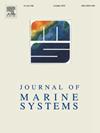Growth potential of Ulva prolifera in the South Yellow Sea and effectiveness of countermeasures
IF 2.5
3区 地球科学
Q2 GEOSCIENCES, MULTIDISCIPLINARY
引用次数: 0
Abstract
The effectiveness of green tide countermeasures was assessed using a model of Ulva prolifera growth factors and drift patterns in the South Yellow Sea. The reliability of the model was confirmed using satellite data showing the green tides in 2018, 2019, and 2021. The point of zero growth (biological zero) was determined to be 5.2 °C. The highest growth potential occurred successively in the sea area near 33.0°N and 123.5°E, Subei Shoal, and the north of Subei Shoal, from April to June, in the same chronological order with ascending order of surface sea temperature. Differences in growth potential were attributed to differences in dissolved inorganic nitrogen. Among the different countermeasures assessed, salvaging floating U. prolifera in open waters and early recycling of Neopyropia rafts were found to be the most effective in reducing the biomass of U. prolifera and the extent of green tides. In comparison, chemical treatment contributed only minimally to the reduction in U. prolifera biomass.
南黄海藻的生长潜力及对策效果
利用南黄海增生藻生长因子和漂变模式模型,对绿潮对策的有效性进行了评价。使用显示2018年、2019年和2021年绿潮的卫星数据证实了该模型的可靠性。确定零生长点(生物零度)为5.2°C。4 ~ 6月生长势最大的海域依次为33.0°N和123.5°E附近海域、苏北浅滩和苏北浅滩以北海域,与海面温度的上升顺序相同。生长势的差异归因于溶解无机氮的差异。在不同的对策中,在开阔水域打捞漂浮藻和早期回收利用Neopyropia木筏对减少藻生物量和绿潮范围最有效。相比之下,化学处理对褐藻生物量的减少贡献很小。
本文章由计算机程序翻译,如有差异,请以英文原文为准。
求助全文
约1分钟内获得全文
求助全文
来源期刊

Journal of Marine Systems
地学-地球科学综合
CiteScore
6.20
自引率
3.60%
发文量
81
审稿时长
6 months
期刊介绍:
The Journal of Marine Systems provides a medium for interdisciplinary exchange between physical, chemical and biological oceanographers and marine geologists. The journal welcomes original research papers and review articles. Preference will be given to interdisciplinary approaches to marine systems.
 求助内容:
求助内容: 应助结果提醒方式:
应助结果提醒方式:


